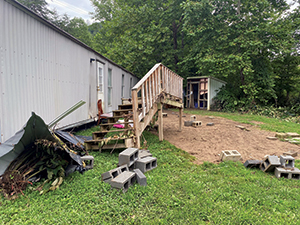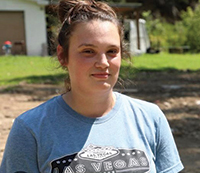
Kathleen Mills shook her husband, Derek, awake one night last July as heavy rains outside their home in Hazard, Kentucky, quickly turned into perilous flooding. When the rising water hit their back door, Mills knew they had to take their two girls to safety.
In ankle-deep water, with a 3-year-old and 8-month-old in tow, Mills escaped to a neighbor’s house on higher ground, waiting for Derek. When he arrived, two words changed their lives forever: “It’s gone.”
“I said, ‘What do you mean?’, and he said, ‘The house—it’s a total loss,’” recalled Mills, who serves in the Kentucky Army National Guard. “There was nothing left, and there was nothing you could do but just watch, pray, hold your kids and be happy they weren’t hurt.”
Troublesome Creek lived up to its name as floodwaters ripped their house from its foundation. The attached power lines kept their dwelling from being entirely swept away.
The overflowing creek was the result of torrential downpours that hit parts of eastern Kentucky last summer, causing flash flooding that left much of 13 counties in ruins. According to Perry County Sheriff Joe Engle, the storm “totally annihilated” the county’s infrastructure.
“Water, telephone, internet, electricity, all the basic roads, all the basic things you would build a community around have just disappeared,” Engle told CNN.
Governor Andy Beshear issued a state of emergency, activating the state’s Emergency Operations Center and authorizing the mobilization of the National Guard. In the weeks and months after the waters receded, the death toll rose to 44 people, while hundreds were left without a roof over their heads.


Mills had limited support until another Guard member told her that DAV was in the area helping veterans affected by the flood. DAV benefits advocates made the trip each day from Louisville to the Department of Veterans Affairs clinic in Hazard, more than 180 miles away, to provide disaster relief.
“The first couple days, it was a little slower, but then word got out very quickly that we were there,” said DAV benefits advocate Randy Bunting, assistant supervisor of the DAV office in Louisville.
Veterans filled the clinic open until close, hoping to receive emergency funding and supply kits.
“There was no such thing as lunch,” he added. “We worked right through it.
“In total, the DAV office in Louisville dispersed nearly $500,000 in disaster relief checks for veterans to purchase immediate needs.”
In Mills’ case, she used her emergency funds to buy food, clothing and propane.
Mills said DAV’s process of approving veterans for such relief was precise and efficient.
“It was incredibly smooth,” she said. “I don’t think it could have gone any better.”
Bunting said that by partnering with the VA clinic, veterans could receive aid at lightning speed. While veterans must show some proof of service, many flood victims lost precious photos, other irreplaceable family keepsakes, and critical financial and life documents.
“Wallets, paperwork … everything got washed down the creek,” added Bunting.
However, since DAV was at the clinic, VA officials verified veterans’ records on the spot, which unlocked emergency money and supplies.
In addition to the funding, Mills received a backpack with blankets and hygiene kits in the days after tragedy struck.
Despite losing so much, she, Derek and their family moved into their new home in Hazard in January and are ready to make new memories.






